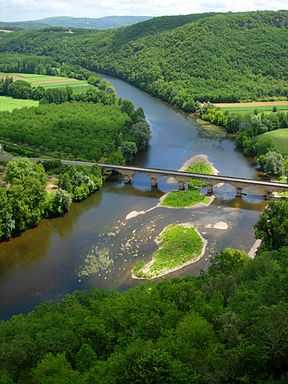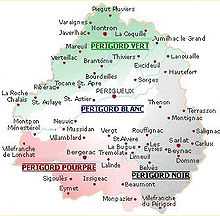Périgord


The Périgord (![]() pronunciation (help·info)) (Occitan: Peiregòrd / Perigòrd) is a natural region and former province of France, which corresponds roughly to the current Dordogne département, now forming the northern part of the Aquitaine région. It is divided into four regions, the Périgord Noir (Black), the Périgord Blanc (White), the Périgord Vert (Green) and the Périgord Pourpre (Purple). The geography and natural resources of Périgord make it a beautiful, unspoiled region rich in history and wildlife,[1] and the newly created Parc Naturel Régional Périgord-Limousin aims to conserve it as such.[2]
pronunciation (help·info)) (Occitan: Peiregòrd / Perigòrd) is a natural region and former province of France, which corresponds roughly to the current Dordogne département, now forming the northern part of the Aquitaine région. It is divided into four regions, the Périgord Noir (Black), the Périgord Blanc (White), the Périgord Vert (Green) and the Périgord Pourpre (Purple). The geography and natural resources of Périgord make it a beautiful, unspoiled region rich in history and wildlife,[1] and the newly created Parc Naturel Régional Périgord-Limousin aims to conserve it as such.[2]
The area is noted for its cuisine, more particularly its products related to ducks and geese, such as foie gras.[3] It is one of the truffle areas of France, historically the most famous.[4] Périgourdine wines include the famed Bergerac (red and white) and Monbazillac.
The préfecture (capital) of the Dordogne is Périgueux. Bergerac in the south and Sarlat in the east are the sub-prefectures. There are Roman ruins in Périgueux which have been restored and the whole area is known as the 'cradle of mankind' due to its wealth of prehistoric sites, of which the most famous prehistoric site is the painted cave of Lascaux, whose depictions of aurochs, horses, deer and other animals (but not of humans) date back some 17,000 years.
The centre of pre-historic studies is the small town of les Eyzies, home to the newly rebuilt Museum of Pre-History, where 19th century archaeological investigations established the valley of the River Vezere as an unusually rich array of pre-historic sites dating back some 40,000 years. One of UNESCO's World Heritage locations, the valley contains 147 prehistoric sites dating from the Palaeolithic era and 25 decorated caves.
The Périgord, one of the main battlegrounds of Hundred Years' War between the French and English in the 14th and 15th centuries, is also the land of 1001 medieval and Renaissance castles like Puymartin, Losse, Hautefort and Beynac situated mainly along the Dordogne and Vézère rivers. Other castles include: Jumilhac le Grand, Fénelon, Biron, Bourdeilles, Castelnaud, Puyguilhem and Rouffiac.
References in popular culture
A visit to the province of Périgord inspired the English novelist Julia Stuart to write her novel The Matchmaker of Périgord.[5]
Michael Crichton's novel Timeline is partially set in 1357 Périgord.[6]
Claude Chabrol filmed his classic thriller Le Boucher here in 1970, with references to Bergerac and the cinema at Sarlat.
The Martin Walker crime novels featuring Bruno Courreges, chief of police, set in the fictional town of St. Denis on the Dordogne river.[7]
In Christian Vincent's 2012 film Haute Cuisine (French title: Les Saveurs du Palais), the protagonist Hortense Laborie is a chef from Périgord.[8]
See also
- de Talleyrand-Périgord
- Wolves of Périgord
- Bouriane
References
- ↑ "Dordogne travel guide". The Telegraph. 4 January 2013. Retrieved 8 April 2013.
- ↑ "Parc Naturel Régional Périgord-Limousin". Parc Naturel Régional Périgord-Limousin. Retrieved 8 April 2013.
- ↑ "Foies gras du Périgord". FoieGras-Perigord. Retrieved 8 April 2013.
- ↑ "All About Truffles: Black Truffles from Perigord, France". MirePoix. 2004-2011. Retrieved 8 April 2013.
- ↑ "Author Interview with Julia Stuart". HarperCollins. Retrieved 24 December 2009.
- ↑ "Timeline". Michael Crichton the official site. Retrieved 8 April 2013.
- ↑ Bruno Courreges, chief of police (fictional)
- ↑ Ferguson, Liz (March 1, 2013). "Review: Les Saveurs du Palais (Haute Cuisine)". The Gazette (Montreal). The Cine Files (blog). Retrieved October 9, 2013.
External links
- Castle and Garden of Losse
- Castle of Castelnaud
- Castle of Hautefort
- Castle of Jumilhac
- Rouffignac Cave
- Lascaux Cave
- B&B Perigord
Coordinates: 45°11′N 0°43′E / 45.183°N 0.717°E